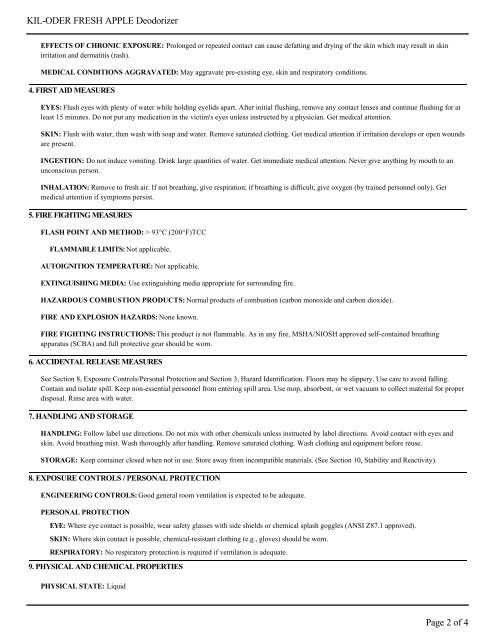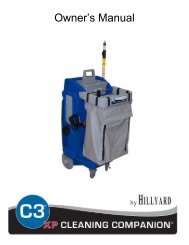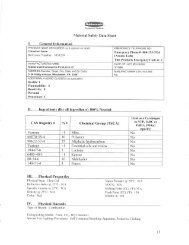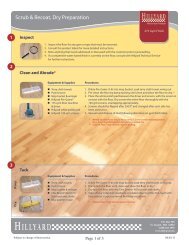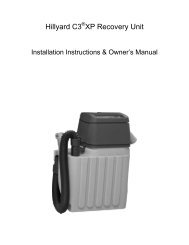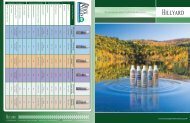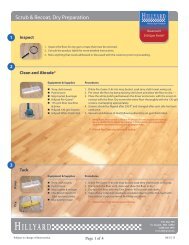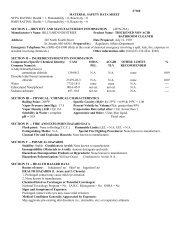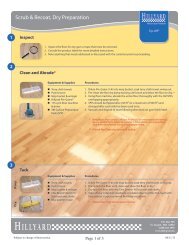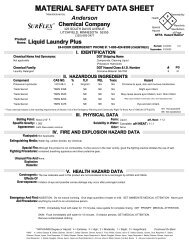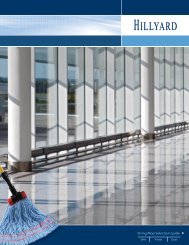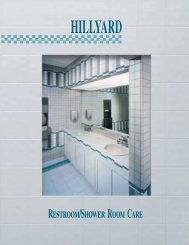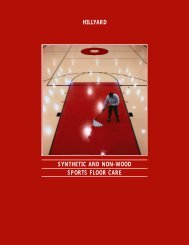KIL-ODER FRESH APPLE Deodorizer
KIL-ODER FRESH APPLE Deodorizer
KIL-ODER FRESH APPLE Deodorizer
You also want an ePaper? Increase the reach of your titles
YUMPU automatically turns print PDFs into web optimized ePapers that Google loves.
<strong>KIL</strong>-<strong>ODER</strong> <strong>FRESH</strong> <strong>APPLE</strong> <strong>Deodorizer</strong><br />
EFFECTS OF CHRONIC EXPOSURE: Prolonged or repeated contact can cause defatting and drying of the skin which may result in skin<br />
irritation and dermatitis (rash).<br />
MEDICAL CONDITIONS AGGRAVATED: May aggravate pre-existing eye, skin and respiratory conditions.<br />
4. FIRST AID MEASURES<br />
EYES: Flush eyes with plenty of water while holding eyelids apart. After initial flushing, remove any contact lenses and continue flushing for at<br />
least 15 minutes. Do not put any medication in the victim's eyes unless instructed by a physician. Get medical attention.<br />
SKIN: Flush with water, then wash with soap and water. Remove saturated clothing. Get medical attention if irritation develops or open wounds<br />
are present.<br />
INGESTION: Do not induce vomiting. Drink large quantities of water. Get immediate medical attention. Never give anything by mouth to an<br />
unconscious person.<br />
INHALATION: Remove to fresh air. If not breathing, give respiration; if breathing is difficult, give oxygen (by trained personnel only). Get<br />
medical attention if symptoms persist.<br />
5. FIRE FIGHTING MEASURES<br />
FLASH POINT AND METHOD: > 93°C (200°F)TCC<br />
FLAMMABLE LIMITS: Not applicable.<br />
AUTOIGNITION TEMPERATURE: Not applicable.<br />
EXTINGUISHING MEDIA: Use extinguishing media appropriate for surrounding fire.<br />
HAZARDOUS COMBUSTION PRODUCTS: Normal products of combustion (carbon monoxide and carbon dioxide).<br />
FIRE AND EXPLOSION HAZARDS: None known.<br />
FIRE FIGHTING INSTRUCTIONS: This product is not flammable. As in any fire, MSHA/NIOSH approved self-contained breathing<br />
apparatus (SCBA) and full protective gear should be worn.<br />
6. ACCIDENTAL RELEASE MEASURES<br />
See Section 8, Exposure Controls/Personal Protection and Section 3, Hazard Identification. Floors may be slippery. Use care to avoid falling.<br />
Contain and isolate spill. Keep non-essential personnel from entering spill area. Use mop, absorbent, or wet vacuum to collect material for proper<br />
disposal. Rinse area with water.<br />
7. HANDLING AND STORAGE<br />
HANDLING: Follow label use directions. Do not mix with other chemicals unless instructed by label directions. Avoid contact with eyes and<br />
skin. Avoid breathing mist. Wash thoroughly after handling. Remove saturated clothing. Wash clothing and equipment before reuse.<br />
STORAGE: Keep container closed when not in use. Store away from incompatible materials. (See Section 10, Stability and Reactivity).<br />
8. EXPOSURE CONTROLS / PERSONAL PROTECTION<br />
ENGINEERING CONTROLS: Good general room ventilation is expected to be adequate.<br />
PERSONAL PROTECTION<br />
EYE: Where eye contact is possible, wear safety glasses with side shields or chemical splash goggles (ANSI Z87.1 approved).<br />
SKIN: Where skin contact is possible, chemical-resistant clothing (e.g., gloves) should be worn.<br />
RESPIRATORY: No respiratory protection is required if ventilation is adequate.<br />
9. PHYSICAL AND CHEMICAL PROPERTIES<br />
PHYSICAL STATE: Liquid<br />
Page 2 of 4


